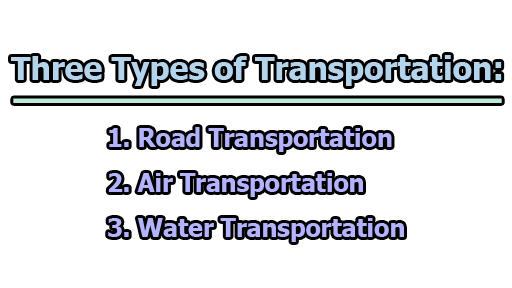Three Types of Transportation:
Transportation is the lifeblood of modern society, enabling the movement of people and goods across vast distances with unprecedented speed and efficiency. In this article, we will explore three types of transportation – Road Transportation, Air Transportation, and Water Transportation – each with its unique characteristics and examples that exemplify their significance in our daily lives. From the familiar roads that connect our cities to the boundless skies that make global travel possible and the expansive waterways that facilitate international trade, these modes of transportation form the arteries of our interconnected world.
1. Road Transportation:
Road transportation is a versatile and widely used mode of transportation that involves vehicles operating on roads, including cars, buses, trucks, motorcycles, and bicycles. It is often the most accessible mode for individuals and provides vital support for the movement of goods and people. Here are some examples and an analysis of road transportation:
1.1 Personal Vehicles:
- Cars: Private cars are one of the most common forms of road transportation. They offer individuals and families a high degree of flexibility and convenience for commuting and travel. The popularity of cars can be seen in various models from different manufacturers. For example, the Toyota Camry is a widely recognized and popular car model known for its reliability and fuel efficiency. It’s used for daily commutes, family trips, and leisure travel.
- Motorcycles: Motorcycles are a distinctive category of personal road transportation, particularly suited for solo commuting and navigating congested urban areas. A well-known example is the Harley-Davidson Sportster, a classic and iconic motorcycle model that appeals to riders seeking a blend of power and style. The Sportster is celebrated for its design, and it represents the freedom and thrill associated with motorcycle riding.
Personal vehicles like cars and motorcycles are an integral part of daily life for many people, providing autonomy and convenience. They are available in a wide range of makes and models, offering diverse choices to cater to individual preferences and needs.
1.2 Public Transportation:
- Buses: Public buses are a fundamental component of urban transportation systems. They provide an affordable and accessible means of transit for a large portion of the population, reducing traffic congestion and environmental impact. Iconic examples include the London double-decker buses, which have become a symbol of the city. These buses are not only efficient but also offer tourists an opportunity to see the city from a unique vantage point.
- Trains: Trains are another essential element of public transportation, connecting cities and regions with efficient and often high-speed service. The Shinkansen in Japan, commonly known as the “bullet train,” is a remarkable example of this. The Shinkansen is celebrated for its cutting-edge technology, punctuality, and exceptional speed, which allows passengers to traverse long distances in a short time. It has revolutionized transportation in Japan and is an inspiration for high-speed rail systems globally.
Public transportation, including buses and trains, plays a critical role in reducing traffic congestion, conserving energy, and promoting sustainability in urban areas. They offer an efficient and cost-effective means of commuting and traveling.
1.3 Goods Transportation:
- Trucks: Trucks are the workhorses of the road transportation industry, responsible for the movement of goods across vast distances, supporting supply chains and the economy. A notable example is the Volvo FH, a popular model known for its reliability and efficiency. The Volvo FH is used in various industries, from logistics and retail distribution to construction and agriculture. Its adaptability and robust design make it suitable for a wide range of applications.
- Delivery Vans: Companies like UPS and FedEx rely on delivery vans to provide courier and package delivery services. These vans are often customized for the specific needs of the delivery companies. For instance, the Mercedes-Benz Sprinter is commonly used for delivery services due to its spacious cargo capacity, fuel efficiency, and driver comfort. It ensures that packages and parcels are efficiently delivered to their destinations.
Trucks and delivery vans are essential for the transportation of goods, ensuring that products reach consumers and businesses in a timely and efficient manner. They are a lifeline for the modern economy, supporting various industries by enabling the distribution of goods on a local and international scale.
2. Air Transportation:
Air transportation involves the use of aircraft to transport people and cargo through the air. It is known for its exceptional speed and the ability to connect distant locations quickly. Here, we delve into the various aspects of air transportation, along with specific examples:
2.1 Commercial Airlines:
- Boeing 747: The Boeing 747, often referred to as the “Jumbo Jet,” is an iconic commercial aircraft that has played a pivotal role in the history of air transportation. Introduced in the late 1960s, the Boeing 747 is renowned for its size, capacity, and long-range capabilities. It has been a workhorse for many airlines, including British Airways and Lufthansa, and continues to be a symbol of international air travel. The 747 has contributed significantly to the globalization of air transportation, making long-haul flights more accessible and efficient.
- Airbus A380: The Airbus A380 is the world’s largest passenger aircraft, designed to carry a substantial number of passengers in comfort and luxury. With its two full-length passenger decks, the A380 offers unparalleled space and amenities for travelers. Emirates is one of the leading airlines that operate the A380, providing passengers with a luxurious flying experience. The A380 has redefined air travel by offering a new level of comfort, entertainment, and efficiency on long-distance routes.
Commercial airlines like the Boeing 747 and Airbus A380 have revolutionized international air travel by enabling airlines to transport large numbers of passengers across the globe efficiently.
2.2 General Aviation:
- Cessna 172: The Cessna 172 is one of the most popular and enduring aircraft in the general aviation category. It is a four-seat, single-engine aircraft that caters to private pilots, flight schools, and business aviation. The Cessna 172 is celebrated for its reliability, ease of operation, and versatility. Private individuals, flying enthusiasts, and flight training schools around the world use it for various purposes, including recreational flying, flight instruction, and short-distance business travel.
- Helicopters: Helicopters, such as the Bell 206, serve diverse roles in air transportation. The Bell 206, a versatile and widely used helicopter model, is employed for a range of missions, from medical evacuation and law enforcement to aerial tours and offshore oil platform transport. Helicopters provide the advantage of vertical takeoff and landing, making them valuable in situations where access to traditional runways or landing sites is limited.
General aviation, represented by aircraft like the Cessna 172 and helicopters, contributes to a wide array of activities, including personal travel, pilot training, and specialized missions.
2.3 Cargo Aircraft:
- FedEx Express: FedEx Express operates a fleet of cargo planes designed for the rapid and reliable transport of packages and freight. Aircraft like the McDonnell Douglas MD-11 are used to facilitate global shipping services. These cargo planes are equipped with advanced systems for the efficient sorting and distribution of packages, enabling the timely delivery of goods to destinations around the world. FedEx’s commitment to air transportation has been instrumental in shaping modern global logistics.
- Antonov An-225 Mriya: The Antonov An-225 Mriya is a colossal cargo aircraft and holds the distinction of being the world’s largest and heaviest cargo plane. It was designed to transport oversized and exceptionally heavy cargo, such as industrial equipment and aerospace components. The An-225 has set numerous records for cargo capacity and has been involved in transporting unique and outsized cargo, making it a testament to the capability of air transportation in handling extraordinary logistical challenges.
Cargo aircraft, exemplified by FedEx Express and the Antonov An-225 Mriya, are essential for the timely and efficient movement of goods, supporting global trade and the delivery of time-sensitive cargo.
3. Water Transportation:
Water transportation encompasses various modes of moving people and goods across water bodies, including oceans, seas, rivers, and lakes. It has been a critical part of global trade, commerce, and travel for centuries. Here, we explore the diverse aspects of water transportation, including specific examples:
3.1 Merchant Shipping:
- Container Ships: Container ships are the workhorses of international trade, designed to transport standardized containers filled with a wide range of goods. Among these, the Maersk Triple E-class container ships are notable. These colossal vessels are known for their exceptional size and fuel efficiency. They play a crucial role in connecting global supply chains by transporting goods between continents. The Maersk Triple E-class ships represent a blend of cutting-edge engineering and sustainability efforts, as they are designed to reduce environmental impact while maximizing cargo capacity.
- Oil Tankers: Oil tankers are designed to transport crude oil and petroleum products across the world’s oceans. The TI Class Supertankers, including the TI Oceania, are examples of the largest oil tankers in operation. These massive vessels can carry millions of barrels of oil, ensuring the efficient distribution of energy resources on a global scale.
Merchant shipping, represented by container ships and oil tankers, is the backbone of international trade, moving goods and resources essential for economies around the world.
3.2 Passenger Ships:
- Cruise Ships: Cruise ships are a prominent segment of water transportation, offering travelers luxurious and leisurely journeys. The Royal Caribbean’s Symphony of the Seas is a remarkable example of a modern cruise ship. It is known for its size and a wide array of amenities, including restaurants, theaters, water slides, and even a central park. Cruise ships like the Symphony of the Seas provide passengers with a floating resort experience, allowing them to explore multiple destinations in one trip.
- Ferries: Ferries are a vital part of local and regional water transportation, especially in areas with numerous islands or coastal communities. The Staten Island Ferry in New York City is a famous example, connecting Staten Island to Manhattan. It not only serves as a commuter transport but also offers passengers stunning views of the Statue of Liberty and the Manhattan skyline.
Passenger ships, including cruise liners and ferries, offer not only transportation but also unique travel experiences, catering to tourists and local commuters alike.
3.3 Inland Waterways:
- Riverboats: Riverboats are commonly used on navigable rivers, offering transportation and leisure cruises. The Mississippi River is known for its riverboat cruises. These boats allow passengers to enjoy scenic trips while exploring the culture and history of the region. Riverboats often feature paddlewheel propulsion, providing a nostalgic and picturesque experience.
- Canal Barges: Canal barges are used on canal systems, like the French Canal du Midi. These vessels transport cargo and passengers along intricate waterway networks. Canal barge travel is a unique and tranquil mode of transportation, allowing travelers to appreciate the beauty of rural landscapes and historical sites.
Inland water transportation, through riverboats and canal barges, offers a charming and eco-friendly way to explore picturesque waterways, providing a contrast to the vast scale of ocean and sea transport.
In conclusion, in the vast tapestry of human civilization, transportation has played a pivotal role in knitting together the threads of our lives. Road transportation, with its ubiquitous presence and flexibility, serves as the veins of urban mobility. Air transportation, exemplified by the grandeur of commercial airlines and the efficiency of cargo planes, propels us towards global connectivity and adventure. Water transportation, including massive container ships and leisurely riverboats, binds nations through the flow of goods and the exploration of cultures. As these three types of transportation continue to evolve and expand, they remain fundamental in shaping our world and propelling us towards an interconnected future, where people and goods move seamlessly, and our horizons extend beyond the limitations of time and space.

Library Lecturer at Nurul Amin Degree College










